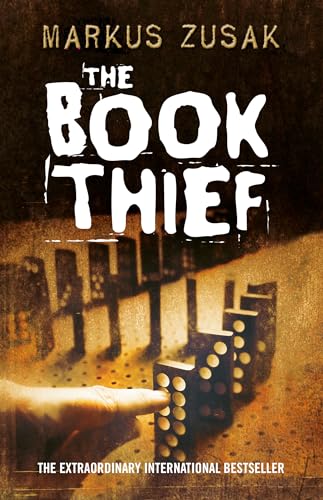Hey there, book lovers! Today we have a review of Markus Zusak’s The Book Thief. This novel is one that takes you on a roller coaster of emotions, with its poetic prose and unique storytelling style. We’ll talk about the narrative style, character development, relationships, historical context, and themes of death and humanity. So, buckle up and let’s see what makes this book a must-read and what might not click with everyone.
In a Nutshell
Markus Zusak’s The Book Thief is a historical fiction novel set during World War II in Nazi Germany. This gripping story follows young Liesel Meminger, who finds solace in stealing books and sharing them with others. Narrated by Death itself, the book delivers a fresh perspective on the harsh realities of war. It delves into themes of innocence, resilience, and the power of words.
With poetic prose and emotional depth, Zusak crafts a tale that’s both heart-wrenching and inspiring. It’s a must-read for fans of historical fiction and anyone interested in stories about the human spirit in the face of adversity.
The Unique Narrative Style and Perspective of Markus Zusak
Narrative style and perspective are crucial to any book, and Markus Zusak knows how to play this game like a pro. When I first picked up The Book Thief, I was ready for an adventure, but I didn’t expect Death to be my guide. Yes, you read that right – Death! This unusual narrator added a different flavor to the story, making it not just another historical novel. It’s like having a chat with your slightly morbid, but charming, friend over coffee.
The narrative perspective in Zusak’s work can switch gears without giving readers whiplash. In his lesser-known gem I Am the Messenger, he shows us the world through Ed Kennedy, a 19-year-old cab driver. Zusak has this knack for making you feel like you’re wearing the protagonist’s shoes – and sometimes, like in Ed’s case, they don’t fit very well!
What truly sets Zusak apart is his ability to mix poetic prose with raw, emotional storytelling. One moment you’re reading a sentence that feels like a punch to the gut, and the next, you’re floating on a cloud of beautiful imagery. It’s an emotional rollercoaster, but hey, who doesn’t love a good ride?
However, it’s important to note that this unique style may not be everyone’s cup of tea. Some folks might find the shifting perspectives or poetic flair a tad disorienting. But for those willing to embrace the unusual, it’s a reward worth the effort.
Now, let’s strap in and explore how Markus Zusak breathes life into his characters and their complex relationships in the next section.
Character Development and Relationships in Markus Zusak’s Works
Markus Zusak knows a thing or two about building characters. When I first read The Book Thief, I was blown away by how real and relatable the characters felt. Zusak has a knack for making you care about people in his stories. For example, Liesel Meminger isn’t just a young girl in Nazi Germany. She’s a fighter, a lover of books, and someone you feel you’ve known your whole life.
His characters also grow and change in ways that feel genuine. Hans Hubermann’s transformation from a humble painter to a brave protector is compelling. Rosa Hubermann, who at first seems gruff and mean, reveals layers of kindness and depth. Zusak often puts his characters through the wringer, but that’s what makes their relationships so strong and believable.
And let’s not forget Rudy Steiner. His friendship and the budding romance with Liesel are heartwarming and tragic at the same time. You can’t help but root for them. It’s relationships like these that keep you glued to the pages.
However, not everyone might enjoy the slow pacing needed to develop these rich relationships. At times, the story can drag, making you wish it would just get on with it. But for those who appreciate deep character studies, Zusak’s work is a treasure trove.
Next up, let’s journey into the historical context and accuracy of Zusak’s writing. Hold onto your hats!
Historical Context and Accuracy in Markus Zusak’s Work
Markus Zusak is a master at weaving historical context into his narratives. In ‘The Book Thief,’ for example, he transports readers to Nazi Germany, capturing the era with striking detail. As I read, I felt like I was walking the bombed streets of Molching or sitting in the Hubermanns’ basement with Liesel and her books.
Zusak doesn’t just throw in historical facts to sound smart. He makes them part of the story’s fabric. You’ll find yourself learning about World War II’s impact on ordinary people while being captivated by the plot. However, don’t expect a history lesson. Zusak’s focus is more on the emotional and psychological toll of the era than on precise dates and events.
Now, let’s talk about accuracy. Zusak takes some liberties for the sake of narrative flow, but it doesn’t hurt the story. For example, while the portrayal of Nazi Germany is generally accurate, there are moments when the story’s fictional elements overshadow strict historical accuracy. But hey, that’s what keeps us turning the pages, right?
One downside is that if you are a history buff looking for a fact-filled read, you might find yourself nitpicking. But for most of us, Zusak’s blend of history and fiction offers a rich, emotional experience that feels both authentic and compelling.
Next up, we’ll explore how Markus Zusak delves into themes of death and humanity in his work. Trust me, it gets deep!
Themes of Death and Humanity in Markus Zusak’s Work
Markus Zusak’s books are a fascinating look at the themes of death and humanity. In his novel, The Book Thief, death is not just a theme but a narrator! How’s that for flipping the script? It’s like getting life advice from a Grim Reaper who’s had too many cappuccinos.
Death in Zusak’s works isn’t your typical scythe-carrying spook. It’s more like a reflective philosopher, pondering human nature. This portrayal adds depth to the story and makes us think about our own mortality. I remember reading it on a gloomy Sunday afternoon; it was the perfect mix of chilling and thought-provoking.
Then there’s the theme of humanity. Zusak excels at showing the best and worst of people. His characters face extreme situations, and you see real human emotions. They laugh, they cry, they adapt. It’s like watching your favorite soap opera but with more historical depth and less dramatic hair flips.
Not everyone will vibe with his poetic style. Some might find the pace slower than a turtle stuck in peanut butter. But if you’re in for the long haul, the journey is worth it. Zusak explores what it means to be human in ways that are both heartwarming and haunting.
Would I recommend it? Absolutely! Just make sure you bring a box of tissues and maybe a comforting snack. You’re in for an emotional ride but one that’s well worth it.
Conclusion
Hey there, book lovers! We’re wrapping up our review of Markus Zusak’s The Book Thief. This book mixes poetic prose and emotional storytelling, offering a unique narrative style. Zusak excels in creating relatable characters and believable relationships, even if the story can be slow-paced at times. The historical context blends true elements with fiction, making it engaging though not super precise. The themes of death and humanity are deep and emotional, making it a recommended read. If you’re up for a heartfelt journey through WWII with a touch of magic in words, this book is one for the shelves. But be warned, it might not be for everyone. That’s our honest take—happy reading!


